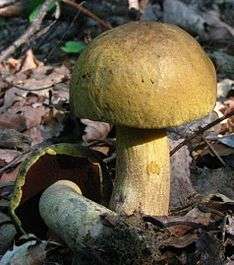Boletus vermiculosoides
Boletus vermiculosoides is a species of bolete fungus in the family Boletaceae. Found in North America, it was described as new to science in 1971 by mycologists Alexander H. Smith and Harry Delbert Thiers. The type collection was made by Smith in Hartland, Michigan, in 1966.[1]
| Boletus vermiculosoides | |
|---|---|
 | |
| Scientific classification | |
| Kingdom: | |
| Division: | |
| Class: | |
| Order: | |
| Family: | |
| Genus: | |
| Species: | B. vermiculosoides |
| Binomial name | |
| Boletus vermiculosoides A.H.Sm. & Thiers (1971) | |
Description
The cap pileus is 4–12 cm across; hemispherical and dull yellow, appearing unpolished, slightly rough and fibrous in texture when young, maturing to broadly convex or slightly depressed in the center, turning tobacco brown to sooty yellow. Occasionally becoming mottled darker brown, with an incurving margin which sometimes develops lobes of localized growth. The context is thick, rigid and firm which is lemon yellow when young, then fades to pallid yellow as it matures, and bruising blue to somewhat greenish in the stipe.
Stipes are 4 to 9 cm long, 1 to 2 cm thick, and solid appearing a washed out olive yellow color when young and paling with age except where larvae damage occurs it is brown and lacking any reticulation.
Pore tubes under the cap are pale-olive, depressed to nearly free, bruising a dull bluish when cut and are very closely spaced wit 2 to 3 per mm. Each tube is dark tea to dark amber when young and fresh, paling to cinnamon with age but never red, bruising blue which fades to orange.
Identification
Very similar to B. vermiculosus in the field, but B. vermiculosus spores are larger at 11-15 X 4.5-5.5 um, and the cuticle of B. vermiculosoides lacks the long cylindrical cells (trichodermium) of B. vermiculosus.
Under a microscope, the spores measure 9-12 x 3-3.5 um, appear smooth with no apical pore, the profile view appears slightly inequilateral, the face view is elongated and slightly spindle shaped. Spore bearing surfaces, Basidia contain 4 spores, measure 20-26 X 7-9 um, appear split clavate and turn glossy to transparent in KOH, with a soft yellowing in Melze's reagent.
Chemical Reactivity: Ferrous sulfate (FeSO4) solution has no reaction in flesh or stipe, potassium hydroxide (KOH) solution stains cutis very dark brown, stains flesh yellow. Spores stain yellow in KOH, less yellow in Melzer's reagent
Habit, habitat, and distribution
Gregarious under oak.[1]
References
- Thiers HD, Smith AH (1971). The Boletes of Michigan. Ann Arbor, Michigan: University of Michigan Press. pp. 337–338. ISBN 0-472-85590-5.